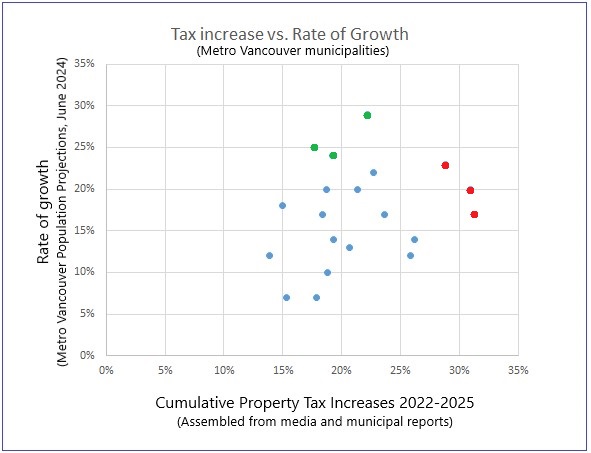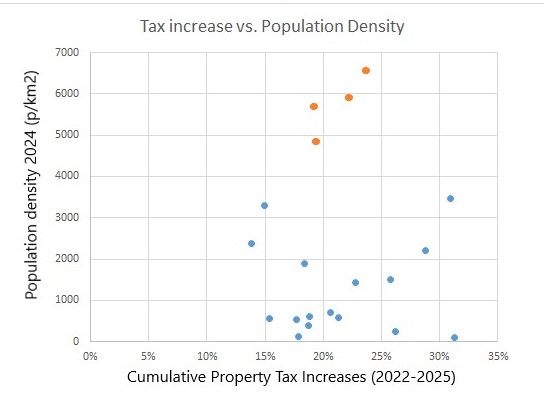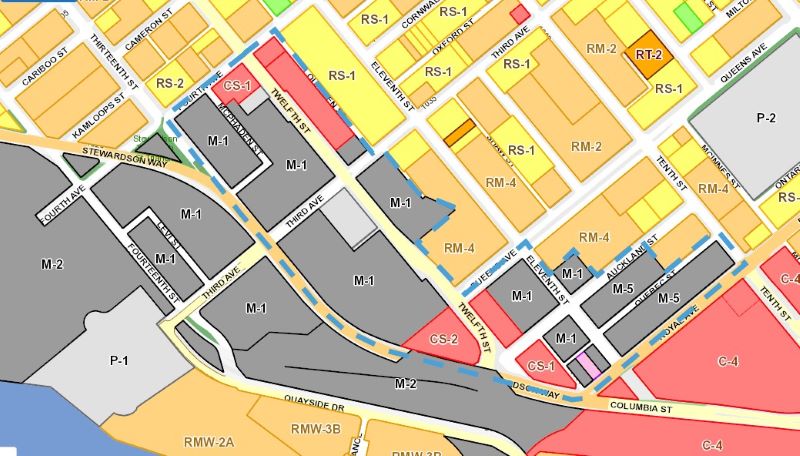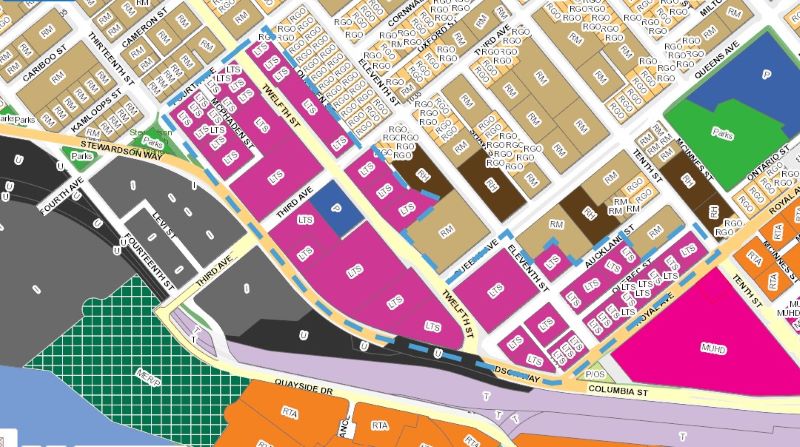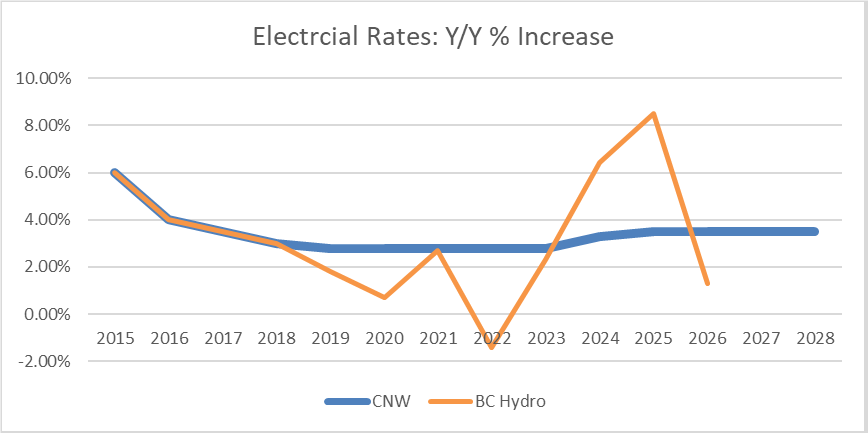Another exciting Monday Night in New Westminster Council Chambers! We managed to get through a pretty deep agenda fairly quickly, starting with moving these items On Consent:
Development Cost Charges Expenditure Bylaw No. 8513
DCCs are money collected from developments in the City to pay for the growth proportion of infrastructure upgrades and replacements. This is the primary and regulated way development is charged its “fair share” of infrastructure costs. The City has multiple separate DCC accounts for water, sanitary and storm sewers, and parkland acquisition. For technical reasons related to how DCCs must be directly costed to identified projects, we run separate DCC accounts for Queensborough and the mainland related to the differing costs between developing utilities in Queensborough and the mainland.
In order for the City to apply accumulated DCC funds to projects, we first have to identify those projects through our annual Capital Plan, then we need to pass a Bylaw permitting the funds from the DCC reserves to be applied. This is that Bylaw.
By this Bylaw, we plan to apply $1.53M from the existing DCCs to our capital plan for 2025. Most of this is for the ongoing mainland sewer separation/upgrade projects and related water service upgrades, and for debt payments we are still making on the Pier Park purchase.
Proposed Delegation of Select Construction Noise Bylaw Exemption Requests
We have been processing a lot of Construction Noise Bylaw Exemptions, and the way we currently process them is a bit onerous for staff. We had 23 applications come to Council in 2024, and all 23 were approved unanimously by Council, indicating that the screening method Staff is using to get these in front of Council is very well aligned with Council’s mindset on these. It is also noted that the vast majority of these applications are senior government projects over which we have limited regulatory recourse, and that we are somewhat disconnected from regional normal here, as our neighboring municipalities permit much more staff delegation of these routine requests. This raises the question of whether the effort and delay to get them in front of Council is needed.
So staff are recommending we shift to something more aligned with best practice. They are not suggesting changing the rules about when an application is deemed appropriate, and all applications for private development will still go through Council, but staff will screen senior government applications and only bring ones of specific concern or deemed questionable to Council. This should take something like 75% of applications off the Council agenda, saving everyone time and money. To make this happen, staff will need to bring Council an amended Bylaw, and Council asked staff to do so.
Next Generation 911 Implementation and Operation Contract
9-1-1 service is moving into the modern era, and this is a much more complicated process than you might anticipate. Moving from a land-line system you can call into with your cell phone, they are moving to an Internet Protocol model which can provide enhanced services from text messages to sending digital media (photo or video), and enhanced locational data.
This is a mandate of CRTC, and the contract is being administered by Metro Vancouver (proving, once again, that Metro Vancouver is not a “sewer company” as its vocal detractors like to say, but is a regional government constituted under the Local Government Act, but I digress…). The City is required to enter this contract, as we need have a common data sharing understanding and our data connections need to be compliant. The City has received an initial grant from UBCM to help with this integration, and is applying for more as this is not a costless exercise.
Alas, one thing not up for negotiation is the contract with a single multinational telecom company to operate our country’s primary emergency communications infrastructure. That decision was made in Ottawa.
We then considered the following items that were Removed from Consent for discussion:
Policy on Routine Release of Closed Council
There are some discussions and decisions we make at Council that can or must be discussed in Closed – that is strictly regulated, and Council acts on advice of the Corporate Officer or (if needed) the City Solicitor. Council does not decide what is in Closed – the law does. However, there is no such regulation about when items are released from Closed, and we have never developed a formal policy to guide the release of decisions made in camera when it is appropriate to do so, rather relying on an ad-hoc process.
The practical reality is that most decisions made in Closed are either never released because Section 90 of the Community Charter does not permit their release (such as personnel files, legal advice, or items regulated by FOIPPA or other senior government regulations), or are defacto released when said decision hits the budget (such as negotiations over land purchase) or operational reports (such as appointing people to Advisory Committees). There is a third category of things that might be discussed in Closed under Section 90 that never go anywhere – such as a land purchase the City decides not to make, or a confidentiality issue that no longer exists for example.
Up to now, we have not had a formal policy or process for Staff to determine to determine if these third type should really be released, or if there are FOIPPA or other statutory issues preventing their release. This does not make us unique in the region or province, most Municipalities larger than us (Vancouver, Surrey) have a process like this while most smaller than us (Port Coquitlam, Port Moody) do not, reflecting perhaps the resource requirements to exercise this process. Fortunately our recently approved budget included adding a staff member in Legislative Services to help us manage records and files, and it is anticipated they can administer a policy here.
Report Back on Community Advisory Assembly Recommendations on Belonging and Connecting
The Community Advisory assembly put a lot of recommendations in front of Council in their year of work, some were direction Council and staff were asking of the Assembly, some they were asked to provide more general advice over how the City can achieve its larger goals. This second category really drew out the creativity and collaboration of the assembly, and the ideas were wide-ranging. When addressing the concept of community belonging, they came with a firehose of ideas that they presented to Council last year. It took some time for staff to go through them and determine how best to proceed with the feedback. Some of the items were already being worked on, and the assembly’s advice demonstrated to staff that they were on the right track. A small number were things the City couldn’t practically or legally do, or were probably best done by other entities. The more interesting group were some new ideas that staff is now reporting back on practicality and potential.
This report includes details of 11 such initiatives, from an enhanced Busking program to an enhanced Grants program and reviewing our facilities rental programs to better support community partners, most of them in progress. With Council’s endorsement, staff will continue to further this work, and if additional budget or staff capacity is required, we will see enhancement requests in our budget process.
Council added two instructions to Staff rising from this, the first to advocate to the Provincial government to restore festival-supporting funds, and a second to expand the scope of the ongoing feasibility study on an all-weather field in Queensborough to include a track.
Response to Notice of Motion: Lower Mainland Local Government Association Tracking and Reporting of Votes on Motions and Resolutions
Back in September this motion was brought by Councillor Nakagawa and unanimously supported by Council, with the idea that the lobbying activities that members of Council take part in should be made transparent. We publicly report on the resolutions we take to Lower Mainland LGA and UBCM, but how we vote on them is not made transparent. As most of the vote at these events are by raised hands in a crowded room, there is no current way to track this. However, electronic voting measures do exist, and are used in some of these events to assure accuracy of result in tight votes, and those may be adapted to keep a record of recorded votes to be tabulated and reported out on later.
This should be an interesting debate at Lower Mainland LGA – not every member of the organization is as committed to transparency as we might like and the extra cost and hassle of creating this transparency might be too much for those members.
Response to Notice of Motion: Regulating Vape Shops
Councillor Henderson brought this motion forward asking that the Province do a better job regulating the sale of vape products and e-cigarettes, in a similar model to alcohol and cannabis, recognizing that any reasonable analysis shows vape products are more harmful to health than cannabis, though the harm is much less that alcohol. I suspect that the Lower Mainland LGA members will pass this with little debate.
Response to Referral: Costs and Logistical Needs to Convene Additional Council Meetings at Queensborough Community Centre
Back in November when we were setting our Council schedule for 2025, Councillor Henderson asked if we could or should do more than one at Queensborough. Council decided a report back on costs and challenges was appropriate, and this is that report. The marginal cost of holding the meeting in Queensborough instead of City Hall is at least $10,000, as there are some significant A/V and site setup costs that are outside of regular costs, and this does not include the extra staff time to do the actual work of moving everything to the QCC, and moving it all back at the end of the night.
Still, we usually get a good turnout in Queensborough, and folks in the community appreciate the gesture that Council makes the trip over there. Staff ar recommending we augment our usual late-September trip to the QCC with another one in early April, and Council agreed.
We then addressed a couple of Motions from Council:
Supporting Advocacy Efforts of BC Urban Mayors’ Caucus
Submitted by Councillor Fontaine
WHEREAS the ongoing challenges of mental health, substance use, homelessness, public safety, and community well-being have become urgent priorities for communities across British Columbia, and;
WHEREAS local governments have a critical role in addressing these challenges and ensuring the well-being of residents, particularly in the areas of substance use treatment, recovery supports, sheltering, and community safety;
THEREFORE BE IT RESOLVED THAT the Mayor continue to advocate to the provincial government the following:
a. Engagement with Local Governments: That the Ministry of Health engage directly with local governments to assess the need for substance use harm reduction, treatment and supports in each community, and to improve local-government involvement in the creation of community-specific mental health supports that are culturally safe and trauma-informed.
b. Expansion of Detox and Recovery Services: That the Ministry of Health immediately expand access to detox beds, sobering beds, and stabilizing beds in every community in British Columbia, ensuring that people in need of urgent care have timely access to appropriate facilities.
c. Provincial Recovery Communities: That the Ministry of Health increase provincially-funded recovery resources, and invest in a comprehensive range of evidence-based programs including recovery, OAT, withdrawal management and others that support individuals seeking long-term solutions to addiction and substance use disorders.
d. Shelter and Housing Standards: That the Ministry of Housing and Municipal Affairs, in collaboration with relevant colleagues, establish shelter unit minimums for each community in British Columbia, and set minimum care and operational standards for sheltering and supportive housing facilities, considering the impact on neighbourhoods and local communities.
e. Reforming BC Housing: That the Minister of Housing and Municipal Affairs implement reforms to BC Housing, including providing BC Housing with a new mandate to work urgently and proactively with municipalities, and establishing BC Housing as the leading agency responsible for sheltering and supportive housing solutions in the province.
f. Support for Community Safety Plans: That the Ministry of Public Safety and Solicitor General, in collaboration with the Ministry of State for Community Safety, create funding and support for local governments developing or implementing community safety and well-being plans.
g. Provincial Urban Safety Improvement That the Ministry of Public Safety and Solicitor General and the Ministry of State for Community Safety create a provincial urban downtown safety improvement plan, addressing the unique challenges faced by urban centers.
h. Bail Reform and Court Efficiency: That the Attorney General act on bail reform, and immediately increase funding for provincial court services to enhance the speed and efficiency in which violent and repeat offenders are processed through the court system.
i. Municipal Infrastructure Funding: That the Ministry of Infrastructure to collaborate with the Ministry of Housing and Municipal Affairs, and the Minister Ministry of Finance to establish a permanent and predictable municipal infrastructure funding program that supports the development and maintenance of essential infrastructure in communities across BC.
j. Collaboration on Social Issues: That the Ministries of Health, Social Development and Poverty Reduction, Housing and Municipal Affairs, and Solicitor General to work collaboratively on the complex issues of poverty, encampments, community well-being, food security, mental health and addictions crises, and street disorder by establishing a roundtable, working group, or committee to address these challenges holistically and effectively.
k. Expansion of Mental Health Response Programs: That the Ministry of Health expand the PACT/CLCR programs and advance civilian-led mental health response initiatives across British Columbia to ensure timely, effective, and compassionate responses to mental health crises.
l. Cannabis Revenue Sharing: That the Ministry of Finance explore cannabis revenue sharing programs with local governments, ensuring that municipalities benefit from the revenue generated by cannabis sales to reinvest in local services and programs.
AND BE IT FURTHER RESOLVED THAT the Mayor share the content of this motion with the provincial government, including relevant ministers, with the request for prompt action on these critical issues affecting communities across British Columbia.
(note: We went through some edits of the language of this motion multiple amendments, I think I got them all here based on my notes, but this is a good time to remind you this is my blog and not an official record, and we can wait until the minutes come out to see exactly what the result was, but I think I am close)
This list of advocacy items was cut-and paste from a letter the BC Urban Mayors Caucus sent to the Premier prior to the Mandate Letters going out to Cabinet, and that slightly clunky approach required us to edit on the fly in Council to make the advocacy points make sense post-Mandate letter. I guess I should be glad that a member of Council who repeatedly insisted that housing and health care are 100% Provincial issues and we should stay in our lane now realizes “local governments have a critical role in addressing these challenges”. Especially after last meeting, when the many advocacy action of the Crises Response Pilot project (eerily familiar here) were opposed by the Councillor moving this motion today.
But today is a new day, and the good news is that we now have unanimity of Council that housing and shelter are critical needs in the community, that the City has a critical role in addressing homelessness, mental health and substance use challenges in our City. So I’ll take that as a win. I think it is important that we speak as one voice on this, and over the last few months staff and council have worked very well to develop a clear vision for our Crises Response work, and I think the best way to assure that vision is realized is if we have a unified voice to the Provincial government on what the collective will of the community is. I will take the items above with me to Victoria next week as I received and invitation from the Minister of Finance to attend the Budget Speech and already have meetings with a number of Cabinet Ministers lined up while I am over there.
Consolidation of Public Compensation for Council Members
Submitted by Councillor Minhas
WHEREAS it has been reported that select Mayors in the Metro Vancouver area can earn as much as the Prime Minister of Canada and significantly more than the Premier of British Columbia on an annual basis;
WHEREAS a large portion of income for a select group of Metro Vancouver elected officials includes work that is performed for other agencies, organizations and governing bodies funded by municipal taxpayers;
WHEREAS a significant portion of the additional income and payments made to Metro Vancouver elected officials is for work performed during regular business hours.
BE IT RESOLVED THAT the City of New Westminster prepare a comprehensive annual financial report (starting in the 2024 calendar year) that details the total compensation received by Council members who serve on regional or provincial/national organizations, including but not limited to EComm911, Municipal Finance Authority, TransLink, and Metro Vancouver, Union of BC Municipalities (UBCM), Federation of
Canadian Municipalities (FCM) and that this report be made accessible to the public; and
BE IT FURTHER RESOLVED THAT the annual financial report provides a complete itemization of each Council member’s base salary and benefits, as well as per diems, stipends, allowances, retainers, expense reimbursements, and any other compensation associated with their roles.
I have no problem with this as a concept, noting that all payments from organization paid by taxpayers (or ratepayers, in the case of utilities) is publicly disclosed, though the effort to cobble all of this together for 7 members of Council every year when each member serves various roles might be resource intensive, when in the end we’ll just have another report of already-publicly-available information that few people will read except those who revel in the name-and-shame aspect of the very idea that elected officials get paid. Anyway, Council supported it, and we’ll see where this goes.
Just for fun, I used the Google to find my public disclosures from last year:
City of New Westminster: $149,591 (salary) and $17,808 (expenses)
Metro Vancouver: $28,350 (remuneration)
TransLink: $21,440 (remuneration) and $1,177 (expenses)
Municipal Finance Authority: $898 (remuneration)
We then had the following Bylaws for Adoption:
Zoning Bylaw No. 6680, 2001, Amendment Bylaw (805 Boyd Street) No. 8411, 2025
This Bylaw that expands the variety of retail and service businesses that can operate at Queensborough Landing was adopted by Council.
Mobile Food Vending Licence Bylaw No. 7850, 2016, Amendment Bylaw No. 8498, 2025
This Bylaw that expands opportunities for Food Trucks in the city was Adopted by Council.
Shark Fin Regulation Bylaw No. 7564, 2012, Repeal Bylaw No. 8511, 2025
This Bylaw that repeals a bylaw made redundant by our new Business Licensing Bylaw was adopted by Council.
Finally, in a bit of New Business:
Zoning Amendment Regarding Mini Storage
This was a motion brought by staff to reduce the number of zones in the City where Mini Storage would be permitted as-of-right. In effect, it would require that anyone wanting to put a new mini-storage business on a lot with one of three zoning designations (M-1, M-5 and CM-1) would now have to apply for a rezoning, not just a development permit. This would give Council more control over where minis-storages are located.
This motion does not make that change, but askes staff to prepare a Rezoning Bylaw that would make that change. Council voted to support them doing that work, though a number of people on Council raised concerns or points that will no doubt be explored further as the Bylaw is developed and as that zoning bylaw comes back to Council.
And with a few announcements, that brought us to the end of another exciting Monday Night in New West Council










